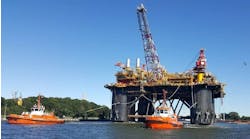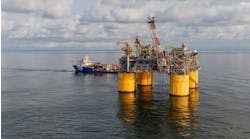Sweden: Record diameter Grade 4 chain for shallow water installation
An order for 3,600 tons of Grade 4 mooring chain has been delivered by Scana Ramnäs to Advanced Production and Loading Systems (APL). The chain was due to be supplied this month as 12 lines of 560 meters comprising 156 mm diameter links, each weighing 306 kg. This is the largest size that Scana Ramn„s has ever manufactured in this grade. The order also included shackles and tri-plates that will be used to connect the chain to wire cables that will form the central section of each mooring line.
As the mooring will be in less than 100 meters water depth, wire rope will be used to reduce weight while maintaining the required yield strength. The wire ropes can be up to 350 mm thick and the tri-plates enable them to be handled more efficiently and also to provide protection against electrolytic corrosion that can arise when a wire rope is connected directly to a mooring chain.
Each tri-plate weighs 1.5 tons. Scana Ramn„s is currently working on a new design that is expected to become available later in the year. The intention is to introduce a version that fulfills the same function as the existing design but is smaller and easier to handle.
Grade 4+
Last year the company supplied 1,000 tons of Grade 4+ chain to Diamond Drilling for use on the Ocean Confidence semisubmersible. The chain is 22% stronger than other chain of the same link size. This makes it possible to upgrade the strength of a rig's moorings without encountering the requirement to fit new and larger mooring winches and fairleads. Use of Grade 4+ on newbuildings also makes it possible to achieve the required mooring strength, yet save up to 8% in weight through the installation of winches and fairleads that are smaller than would otherwise be necessary.
Extensive, expensive testing
Development of the Grade 4+ chain demonstrated that the ductility essential to obtaining high yield strength was significantly higher than that of the existing Grade 4 chain. This has increased the fatigue life of the newer chain by many times and resulted in its being subjected to the most expensive test ever conducted by Scana Ramn„s. Despite being repeatedly subjected to extreme test loads for a considerable length of time, the test chain did not fail. When the chain had demonstrated its ability to exceed all the required standards, the tests were terminated simply to save money, without the company ever discovering the new chain's true fatigue life.
Recently, the company demonstrated its quick delivery capability when it sent 40 tons of chain to a catenary anchor leg mooring buoy installation in Asia using airfreight.
For more information contact Mats Sohlström, Scana Ramn„s, Tel: +46 220 22000, Fax: +46 220 35837, Email: [email protected]
Chain welding process surveillance
When each link on a Scana Ramnas chain can weigh over 500 kg, the discovery of a defective one somewhere along its length could result in the need to handle many tons of metal, if it had to be replaced.
This problem is overcome by a quality control system that monitors the forces being applied by the flush-butt welding system as each link is formed. The automated process uses a combination of electrical heating and compression to create the join. The monitoring system provides the operator with an on-screen graph that represents each of the forces being applied during the formation of the link. Any irregularity in the heating, compression and voltage used is immediately apparent to the operator through a deviation in the alignment of the graphs. This makes it a comparatively simple task to maintain quality by interrupting production at the forging/welding stage and removing the potentially defective link then, instead of during the final inspection, when a change-out would be much more costly. This approach also ensures that all links have been subjected to the same heat treatment, resulting in consistent quality.





